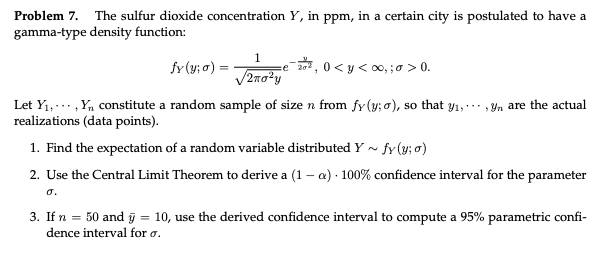Problem 7. The sulfur dioxide concentration Y, in ppm, in a certain city is postulated to have a gamma-type density function: fy (y; 0) = - 7, 0 < y< 0, ;& >0. Let Y1,--- ,Y, constitute a random sample of size n from fy(y:; o), so that y1,--- ,Yn are the actual realizations (data points). 1. Find the expectation of a random variable distributed Y ~ fy(y; o) 2. Use the Central Limit Theorem to derive a (1 – a) - 100% confidence interval for the parameter o. 3. If n = 50 and ỹ = 10, use the derived confidence interval to compute a 95% parametric confi- dence interval for o.
Problem 7. The sulfur dioxide concentration Y, in ppm, in a certain city is postulated to have a gamma-type density function: fy (y; 0) = - 7, 0 < y< 0, ;& >0. Let Y1,--- ,Y, constitute a random sample of size n from fy(y:; o), so that y1,--- ,Yn are the actual realizations (data points). 1. Find the expectation of a random variable distributed Y ~ fy(y; o) 2. Use the Central Limit Theorem to derive a (1 – a) - 100% confidence interval for the parameter o. 3. If n = 50 and ỹ = 10, use the derived confidence interval to compute a 95% parametric confi- dence interval for o.
MATLAB: An Introduction with Applications
6th Edition
ISBN:9781119256830
Author:Amos Gilat
Publisher:Amos Gilat
Chapter1: Starting With Matlab
Section: Chapter Questions
Problem 1P
Related questions
Question

Transcribed Image Text:Problem 7. The sulfur dioxide concentration Y, in ppm, in a certain city is postulated to have a
gamma-type density function:
1
fy (y; o) =
0 < y < 00, ;a > 0.
Let Y1,..., Y, constitute a random sample of size n from fy(y; o), so that Y1, , Yn are the actual
realizations (data points).
1. Find the expectation of a random variable distributed Y ~ fr(y; o)
2. Use the Central Limit Theorem to derive a (1 – a) - 100% confidence interval for the parameter
o.
3. If n = 50 and ỹ = 10, use the derived confidence interval to compute a 95% parametric confi-
dence interval for o.
Expert Solution
This question has been solved!
Explore an expertly crafted, step-by-step solution for a thorough understanding of key concepts.
Step by step
Solved in 7 steps

Knowledge Booster
Learn more about
Need a deep-dive on the concept behind this application? Look no further. Learn more about this topic, statistics and related others by exploring similar questions and additional content below.Recommended textbooks for you

MATLAB: An Introduction with Applications
Statistics
ISBN:
9781119256830
Author:
Amos Gilat
Publisher:
John Wiley & Sons Inc

Probability and Statistics for Engineering and th…
Statistics
ISBN:
9781305251809
Author:
Jay L. Devore
Publisher:
Cengage Learning

Statistics for The Behavioral Sciences (MindTap C…
Statistics
ISBN:
9781305504912
Author:
Frederick J Gravetter, Larry B. Wallnau
Publisher:
Cengage Learning

MATLAB: An Introduction with Applications
Statistics
ISBN:
9781119256830
Author:
Amos Gilat
Publisher:
John Wiley & Sons Inc

Probability and Statistics for Engineering and th…
Statistics
ISBN:
9781305251809
Author:
Jay L. Devore
Publisher:
Cengage Learning

Statistics for The Behavioral Sciences (MindTap C…
Statistics
ISBN:
9781305504912
Author:
Frederick J Gravetter, Larry B. Wallnau
Publisher:
Cengage Learning

Elementary Statistics: Picturing the World (7th E…
Statistics
ISBN:
9780134683416
Author:
Ron Larson, Betsy Farber
Publisher:
PEARSON

The Basic Practice of Statistics
Statistics
ISBN:
9781319042578
Author:
David S. Moore, William I. Notz, Michael A. Fligner
Publisher:
W. H. Freeman

Introduction to the Practice of Statistics
Statistics
ISBN:
9781319013387
Author:
David S. Moore, George P. McCabe, Bruce A. Craig
Publisher:
W. H. Freeman